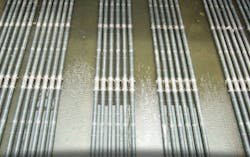The Ommegang Brewery in Cooperstown, N.Y., unable to send its wastewater to the public treatment facility, built its own private 20,000-gpd industrial membrane bioreactor package plant. Planners wanted to make sure that every element of the treatment process was designed to take advantage of the latest in technological advancements to deliver optimal treatment in the least time, with the smallest possible footprint and highest level of efficiency and cost-effectiveness. Rick Debar, technical manager and wastewater treatment plant manager for the brewery, worked with Steve Buttles—project superintendent at Western Water/GW&E of Austin, Texas—to plan the project. The aeration tank holds 150,000 gal, and the design was created with the goal of introducing a sufficient amount of oxygen to meet the biological treatment needs of the process wastewater when the brewery operates at full capacity.
“No other diffusers were considered for this project, given the success we have had with EDI’s products in other plants,” said Buttles. “Our company has had very good results using EDI on other projects, and their fine bubble diffusers work well with our MBR systems. Plus, they were within our budget.”
When approached with the design requirements for the treatment basin, EDI evaluated the facility’s characteristics and product options they could design around.
“Given the relatively high organic loading of the brewing process flows, the use of a [standard] 9-in.-diameter disc product was perceived to provide low value to the customer,” said EDI Project Manager Darin Starr.
That configuration would have yielded only adequate SOTE performance and would require operating the aeration system in the upper range of its capacity. This would have required installing the maximum possible number of diffusers in the basin—equivalent to floor coverage of 35%. Since product geometry limited the ability to increase the number of installable disc diffuser units, this design would not offer the facility an optimal operating system in terms of aeration efficiency or turn-up capacity, should future plant loading need to increase.
The solution
Given the needs of the aeration design, EDI recommended its StreamLine diffuser. Its geometry allows for higher installable diffuser densities—equal to 50% floor coverage—and operating efficiencies greater than that of the 9-in. disc diffuser. The StreamLine diffuser allowed the aeration system to meet the plant’s initial performance objectives while providing the flexibility to increase the process capacity of the treatment system, should the brewery expand production in the future.
The results
The operating performance of the StreamLine diffuser system is greater than what can be achieved by a disc diffuser. With more than 70% more diffuser active membrane area, the brewery now has the capacity to significantly increase production with minimal changes to the operation of the wastewater treatment plant.
“EDI’s service, pricing and product are very good,” said Buttles. “Their systems seem to run very well when installed properly. We are very happy with the results.”
The entire build lasted nine months. Of that, four days were spent installing the EDI StreamLine diffuser aeration system. The total project budget for the plant was $1.2 million, with about $30,000 of that allocated to the aeration elements and installation.



